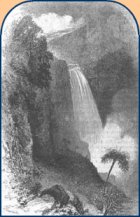
INTRODUCTION
In a surprising number of poems and letters, many of which were sent to her sister-in-law Susan Gilbert Dickinson, Emily Dickinson invokes Brazil, Peru, Veracruz, the Bahamas, India, and other "exotic" places. Sometimes Dickinson uses these place names to describe the advent of spring, sometimes to describe a spiritual state, and sometimes to speak of love. Traditionally, Dickinson's work is understood as a poetry of interiority. And yet Dickinson's use of foreign place names should encourage us to read her poems in a larger context. Some scholars have recently begun to do just this: Ed Folsom and Kenneth M. Price explore the politics of Dickinson's allusions to "Domingo" in "Dickinson, Slavery, and the San Domingo Moment," and Kirsten Silva Gruesz analyzes Dickinson's use of geographic tropes in "The Geographic Imagination in Whitman and Dickinson."
This site suggests that poems and letters that seem, on the surface, to turn inwards can also legitimately be read with the historical context of colonialism and expansionism in mind. It is a mistake to presume that interiority exists in isolation from external worlds, and it is a mistake we often make with Dickinson. As many recent critics have suggested, subjectivity is interiorized with reference to external facts and materials. For Dickinson, and for many other writers, this may mean that the discourse of love is intertwined with the discourse of colonialism—for reasons that are both political and psychological. More generally, this approach should help us to problematize the presumption of two separate worlds—interior and exterior—and to discover that in literature, and quite powerfully in a poet as seemingly private as Dickinson, language moves between the two worlds readily, easily, and with important implications.
Edward Said notes, "all kinds of suppositions, associations, and fictions appear to crowd the unfamiliar space outside one's own." The poems and letters gathered here testify to the power of "exotic" and colonized lands in Dickinson's imagination, revealing perhaps some of the suppositions and associations that defined these lands for Dickinson and perhaps some of the "fictions" that crowded the U.S. national imagination. In the glosses offered alongside each poem, we provide selections from William H. Prescott's History of the Conquest of Peru and definitions from Webster's 1856 dictionary, both were in the Dickinson household, and we provide brief comments on the poems. These glosses, as well as additional images in the nineteenth-century contexts page, should provide other examples of how these lands figured in discourse within the U.S. at the time Dickinson was writing. They may provide images and representations that Dickinson's works echo, revise or reject.
There is not yet any scholarship that speaks directly to the erotics of colonial discourse in Dickinson's work, so the annotated bibliography cites works that have shaped our thinking in creating this site, and works that might be useful for further thinking. We include a handful of standard and recent works on colonial studies, offering speculative comments on possible connections to Dickinson. We also include works that explore Dickinson's relationship with Susan since this site began as an exploration of poems/letters sent to Susan; and we cite works that contribute to the most recent Dickinson editorial projects. In particular, our work is indebted to the Dickinson Electronic Archives and "Emily Dickinson Writing a Poem", electronic editions of Dickinson's writings and the poems/letters Dickinson sent to Susan. When possible, the poems/letters on this site follow the transcriptions of Martha Nell Smith and Ellen Hart in Open Me Carefully, (Paris Press, 1998) which include introductory or concluding salutations to Susan and the line breaks as they appear in the manuscripts. Other transcriptions follow Thomas Johnson's, The Complete Poems of Emily Dickinson published by Harvard University Press. This site also offers suggested student projects that include more of our thoughts on love and conquest in Dickinson, and questions that encourage readers to return to particular poems and with particular issues in mind.
